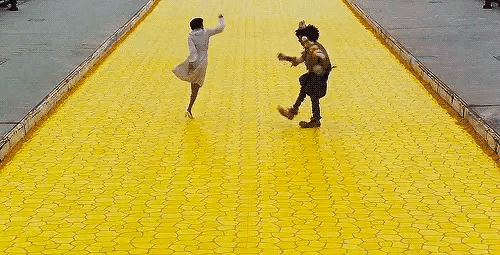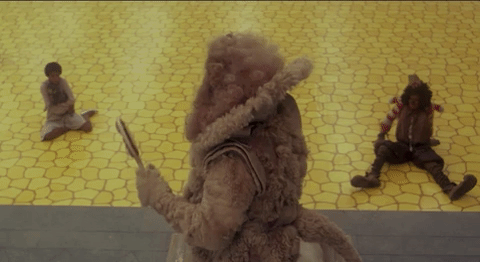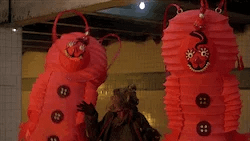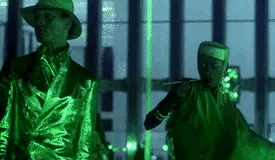32 thoughts I had while rewatching The Wiz (1978)
I wonder how Reese's Pieces feels about its wrapper being the iconic nose for Michael Jackson's Scarecrow...
The following is a series of chronological thoughts I had while recently rewatching The Wiz. I sincerely and deeply admire the playful and creative fusion of black futurism and contemporary black musical theatre layered with an imaginative take on the urban culture of New York City.
When first released, The Wiz did not break even at the box office. It was deemed “too scary for children and too silly for adults.” Yes, I was scared of the munchkins as a child, but I am now a highly silly adult with an appreciation for all art and storytelling. I can’t get enough of the whimsical, empathetic nature of this film. Journey with me and discover or rekindle an appreciation for the masterpiece that is The Wiz.
“The Feeling That We Have” is the very first song in The Wiz. It is performed by the divine Theresa Merrit. Her voice is sweet and deeply warm. Her presence, combined with the apartment decorated in a traditional black household aesthetic, makes me ache for what’s familiar and deeply missed in my life. She sings a mother’s song about undying love and the grief of aging and watching time pass us by. She sings a song reminding us that, often, grief and love cannot exist without the other. I could really write pages about how much this song means to me, but this is only my first thought, and we simply must continue!
I recently heard that Diana Ross was not originally cast as Dorothy. The original actress in mind was around 16 years old. But Diana fought for the role. Tea. Think about it. In many ways, Dorothy’s arch can be considered a coming-of-age story as she develops a deeper sense of self and broadens her perspective of the world. Having Dorothy be in her 40’s creates empathy and relatability. How many times in adulthood have we and will we feel lost, isolated, and misunderstood? How many times in adulthood have we and will we come of age? This process is so normalized for children that we forget that death of self and rebirth is a constant life cycle that escapes no one. Go ‘head, Diana Ross.
*The ringing of a quant telephone*
Excuse me. I must answer the telephone. *Answers* “Hello?….Girl! Whatchu mean there’s a snow tornado running down 125th street!!!?”
And now, forgive me.
In many ways, boots the house down was invited in the scene I will now describe.
Dorothy flies through the winter night sky in a glittery blizzard with pure, effortless, ethereal beauty. Then…
BOOM!!
Light flashes! Smoke! HEELS FIRST, Dorothy SMASHES through the Broadway-esque lit-up sign of OZ. (heels the house down) As she crashes through the glitzy portal door, she, of course, takes out the evil witch that’s been terrorizing the Munchkins. What an entrance!
The munchkins said, “Thank you for killing our oppressor!” And trembling with fear, Diana Ross as Dorothy shrieked, “I ain’t never killed nothing in my life!”
The Munckins’ imaginative blue playground does not get enough credit. So futuristic, playful, and devilishly stunning all at the same time. Secondly, have you ever seen this much periwinkle in a movie? No. Honey, no one’s doing it like The Wiz set designers Robert Drumhellar, Edward Stewart, and Justin Scoppa Jr.
These munchkins can perform, okay!?? The choreo featuring the munchkins running with the frisbees only to transition and become a marching band with invisible instruments? How fun this whole number must have been. What a dream come true for those who were all along, just their childhood selves dancing. I’m inspired.
These off-duty cabs with an attitude make me weak. They simply do not get paid enough!!
And just like that, “Soon as I Get Home” launches Dorothy and subsequently us onto a journey of self discovery. It’s no coincidence that this song starts with Dorothy walking amongst literal destruction and rubble at night, only to end with the sunrise leading her in a new direction.
This song teaches us that we must accept our circumstances, and we must be the ones to grant ourselves permission to discover, grow, and ultimately change our lives. I’ve seen and lived this idea many times. I promise you, friend, this gospel is true.
“As soon as I get home” sounds just like that one Michael Jackson song…..
On my worst days, my inner thoughts have sounded like the relentless, spiteful, mindless bullying of crows. Them labeling themselves as Scarecrow’s friends is insidiously manipulative, my god.
Much like Scarecrow falling after getting off his pole, it is so easy for us to stumble when we first begin a journey of shedding destructive habits. It’s okay. And I would argue, maybe a good thing to experience.
Very curious about the interior shoe design for Scarecrow. Michael Jackson (only nineteen at the time!) is dancing and spinning. These are clown shoes. I wonder what type of interior structure supports this kind of movement.
Now seems as good a time as any to address the colorism in this movie, but more accurately, of this era- and of a lingering mindset. Tinman’s wife, Teenie, and Evilene are bigger, dark skin women. They are thought of as unkind and undesirable and are not spoken about with grace. Glinda, The Good Witch of The South, has light skin and is thought of only as morally pure. The irrefutable function of colorism is an unfortunate shame and stain on the otherwise glittery legacy of The Wiz.
Do not look Nipsey Russel as the Tinman in the eye when you’re high. Word to the wise.
Tinman’s behavior and beliefs toward his wife are insufferably stale, even by today’s standards. Oh, oh, Teenie crushed you in your prime? This statue has a smile on her face and seems like a lovely woman, yet you’re over here depressed and bent out of shape because you can’t support your partner. Yeah, girl, and if you didn’t tear your ACL, you would have gone pro. (I may be discovering that I’m a Tinman Hater??)
However, I will admit…. Tinman does have one of my favorite quotes in the film. “But yours truly is an old trooper, and I quickly made plans for the future.” Period. Let’s keep it pushing. I so relate.
If anything, it is interesting that someone who lacks the ability to access empathy towards his wife yearns to develop feeling and connection. I think this character design directly ties to traditional themes of heterosexual masculinity. More specifically, it demonstrates the masculine tendency for resentment, self-sabotage, and lashing out at the feminine partner when they neglect their own emotional health. Folks, we could talk about this all day. Let’s move on.
The Wiz is so much of a love letter to black invention, expansion, and creativity. I really do appreciate that Tinman’s song is a true country ditty that turns into a southern jazzy show and dance. The Black Southern sound is the very foundation of so much Black American creativity that we have today, and it absolutely deserves a seat at this table.
My dream of directing this musical with an all-black or all-poc high school cast was birthed when recently rewatching Lion’s introductory scene. I genuinely love Dorothy, but I am fiercely fascinated by the dynamic between the trio without her. Michal Jackson, Ted Ross, and Nipsey Russel do an incredible job of creating individual perspectives and group dynamics that function seamlessly with or without our protagonist.
Also, if you can get me the handheld mirror used in I’m a “Mean Ole Lion,” I will rub your back and do your laundry.
If you saw this movie when you were a child, then you were probably also afraid of The Subway Peddler. His little theme song still makes my spine shiver.
I’m well aware that Tinman approaching Lion while saying, “A Lion with no courage. I can’t believe it” is supposed to be indicative of his ever-present empathy and sympathy; however, if someone approached me at my lowest and started calling out my weaknesses…. I would be biting and fist-fighting.
“Stick with the Big Kitty, and you’ll be in heaven!” -Ted Ross as Lion. lol iktr
Shout out to the Brooklyn Bridge for being cast as the yellow brick road.
Oppulance and Black Futurism come alive when the trio arrives in Emerald City. The mile-long golden piano played by a maestro with gold sparkles in his afro- are you kidding me!!
The fanfare used by The Wiz is the very same used in Beyonce Homecoming 2018.
The Wiz invites “the one with the silver slippers” to come see him. However, the guards won’t let Dorothy and her friends up to see The Wiz. So, like a real b*tch, Dorothy speaks into a comically large talking mic and states that she certainly won’t be coming up to see you, Mr. Wiz, uh, Sir, unless her friends can come too. Diana Ross is acting down.
There is a large, thundering BOOM! that knocks back everyone. The Wiz bitterly concedes and allows the “riff-raff” to come up with her. Dorothy wins!
The BOOM! heard in this scene is incredibly reminiscent of the BOOM! that sounded when Dorothy burst through OZ near the beginning of the movie. All I’m sayimg is… Dorothy be taking these oppressors out!!!
Dorothy and her friends having to book a night at The Emerald City Motel after they speak with The Wiz will never not be hilarious to me. It’s giving the last night of a girl’s trip to Miami, and there’s no money or morale left.
In the bottom left corner of the screen at Evillene’s Sweatshop, there is a dancer who is not only doing the choreography but is also shaking that ass, honey. She kills me every time. Because baby whooo told you to shake ass like that?? No one else is doing it like her! I’m so glad she booked! The movie would honestly not be the same without her.
Before I say anything else, let me say that Mabel King provides a legendary performance as Evillene. However, the costumes for The Flying Monkeys and the dancers in Evillene’s Sweatshop were the wrong choice for very obvious reasons having to do with colorism and caricaturism. These choices are disappointing even for this era of time. Also, Eveilene uses a whip, and some of her workers suddenly, coincidently, pass out on the floor during the choreography??? The gospel melody and choreography in “No Bad News” are lovely, but all of these elements combined don’t sit well with me.
The Wiz is cannonly from Atlantic City, New Jersey.
Now, pay attention, children, “Home is a place we all must find, child. It’s not just a place where we eat or sleep. Home is knowing. Knowing your mind, knowing your heart, knowing your courage. If we know ourselves, we’re always home anywhere.” - Lena Horne as Glinda The Good Witch of The South
The Wiz and Dorothy have more in common than they do uncommon. By the end of the movie, The Wiz is forced to face a journey of self-reflection and discovery, much like the one Dorothy embarked on at the beginning of the movie.
Diana Ross should have won several awards simply for her performance of “Home.” I’ll also take this time to point out that, while being transported through dimensions back to her home, Dorothy does some excellent self-therapy to cope with the experience of living in a made up land with silly creatures. When she finally lands in Harlem, she skips off in the snow, holding ToTo, and opens the door to her home like this entire trip didn’t happen.
Damn… almost everything in this movie is that dog’s fault.
The End.







So, it's going to sound like I drop more names than a Kansas tornado drops houses on witches, but my editor Emma's father was Tony Walton, who was both art director and costume designer — sorry to quibble you, but the sets are his, not the set dressers, who are to the art director what seamstresses are to fashion designers. Tony had a distinctive pop-art-ish style, which is why I'm quibbling. There were these weird production designers' guild rules about credits that saw NY production designers demoted to art director, for a start, so he isn't allowed his true title — there is no production designer dredit at all. But it's Tony Walton.
Despite having been nominated for and Oscar for costumes, Tony and everyone associated with it were hugely embarrassed by The Wiz. The choice of social-realist Sidney Lumet as director was widely considered the original sin, and might seem peculiar were he not married into Black royalty: his wife Gail was Lena Horne's daughter.
This is a Black Yankee production, the Obama Martha's Vineyard crowd, sometimes called WASPs — the W in that case means "wealthy." They are my Black counterparts.
I didn't meet Emma until year following its release, when we both enrolled at Trinity, she a senior, I a junior. The first time I saw The Wiz was at a screening Emma and her step-sister Bridget had in their living room of Tony's apartment on the Upper West Side. Afterwards they trotted out various props and sketches of the sets.
Casting Diana Ross and changing the show's original music was widely thought to be the fatal flaw. But setting it in the real New York, rather than the fantasy Oz of the stage musical, is significant: By then it was a city dominated by Black culture and influence. I've come to understand that there is a significant difference in outlooks between Yankee and Southern Blacks, which is explored in some depth in 'The Gilded Age.' That's about my specific socio-cultural group, meaning the stuffy old ones who live across the street. If you watch it, note how there are no Black servants. That is the dynamic after the Civil War that prompted the Great Migration.
But there were already Black Yankees pre-Migration, like Lena Horn's family, and a few friends of mine's ancestors. A recent episode follows Black Yankee journalists being cavalier around Whites, as they would be in NYC, when they go to the South to cover the success of a burgeoning Black community.
#32 took me out.
I love this! I literally was just talking about this with someone the other day! She pointed out how the taxis always leave them, and it cuz in NYC, yellow cabs usually don’t stop for black folks.
Also, the Emerald City sequence goes through the colors of the Afro Diaposa: Green, Red, and Gold/Yellow.
“The Feeling that We Have.” Is in my top 5 of the soundtrack. Love your thoughts.